#Port of Falmouth
Explore tagged Tumblr posts
Text
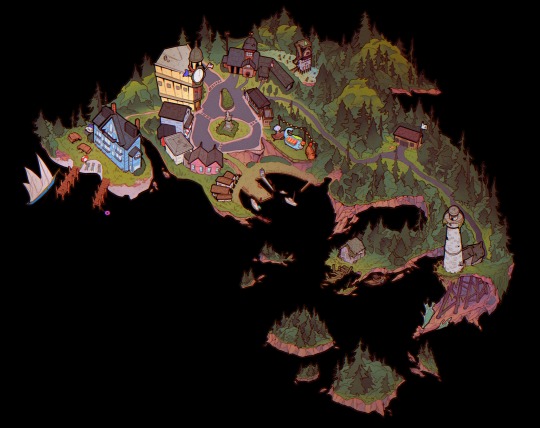
Cape Falmouth Map (2021)
#kodasea#own art#own character#2021 art#art#artists on tumblr#cold case crew#Cape Falmouth#fun map#Making a note to redo this but in an old mariners map way with sea monsters and engraving stylization#Since it was senior port I was doing my best to err on the side of clarity and showcasing the drawing ability#So the bones are good but we gotta go crazy man#Maybe a museum? Perhaps a fisherman town that leads up to a seagull people hamlet#Definitely going to go nuts on those tourist traps and fancy bed and breakfasts#On my trip to Maine there were sooo many cute ones#AKA tourism: the beast that chews my wallet and ravages the land but damn do I love batting my eyes at him too
24 notes
·
View notes
Text
Best things to do in Cornwall
*New post*
Where to stay, what to eat and what to avoid, based on my years of living in and visiting Cornwall.
#travel#europe#food#cornwall#beaches#seaside#history#cornish pasty#pasty#padstow#falmouth#newquay#eden project#port isaac#uk#uk tour#places to visit#visit uk#holiday
2 notes
·
View notes
Text
Top 20 Places to Live in Jamaica: A Comprehensive Guide
Jamaica, renowned for its vibrant culture, stunning landscapes, and warm-hearted people, offers a unique blend of lifestyle choices that cater to diverse preferences. Whether you’re drawn to the bustling urban energy of Kingston, the serene beaches of Negril, or the cool retreats of Mandeville, Jamaica has something to offer for everyone. This Caribbean paradise is not just a popular tourist…
#Falmouth#Kingston#Mandeville#Montego Bay#Negril#Ocho Rios#Port Antonio#Saint Ann’s Bay#Spanish Town#Treasure Beach
0 notes
Text
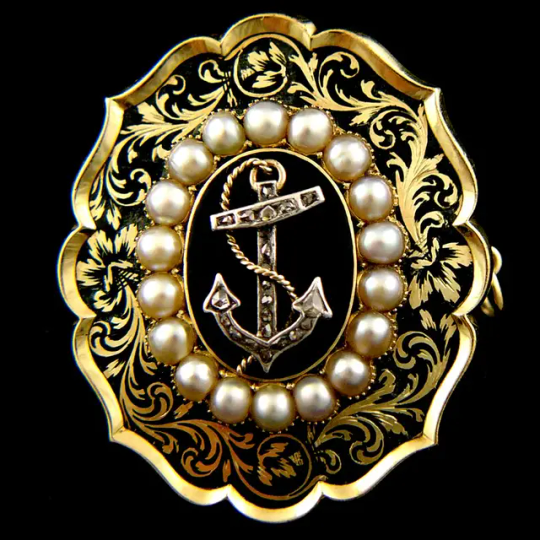

Memorial Brooch to Rear Admiral McKerlie, Died 12th Septr 1848. Aged 74 years, 1848
Rear Admiral John McKerlie (1774-1848) entered the Royal Navy as a volunteer in April 1794 having been at sea in the Atlantic and Baltic merchant service from a young age. Rated Able Seaman, he was sent from the receiving ship Royal William to join the elite frigate force based at Falmouth that cruised the Channel countering the activities of French commerce raiders. McKerlie was assigned to the frigate Arethusa (38) commanded by one of the most successful frigate captains of the day, Captain Sir Edward Pellew.
In early 1795 McKerlie followed Pellew into the 44-gun heavy frigate Indefatigable with the rate of Quarter-Gunner. Owing to a sound Scottish education and his knowledge of the sea McKerlie was soon acting as Indefatigable’s schoolmaster instructing the other eighteen ‘young gentleman’ of the gunroom in the specifics of their profession, having himself been appointed a midshipman. Throughout 1795 and 1796 he participated in the capture of the numerous French prizes which brought further fame and glory to Sir Edward Pellew. It was however early the next year that Indefatigable fought what is generally regarded as one of the boldest frigate actions of the French Revolutionary War.
On the dark and stormy night of 13 January 1797 the French 74 Droits de l’Homme was sighted off the Brittany coast. Pellew, recognizing that he was heavily outclassed, saw that the waves prevented his opponent from opening the lower gun ports and that the severe weather had caused the loss of the enemy’s topmasts. Seizing the initiative, Indefatigable closed followed by the frigate Amazon and raked the French ship of the line at every opportunity. The enemy replied with 4,000 canon balls over the next few hours until finally driven in to Audierne Bay irreparably damaged by British gunfire and the unabated gale. The sight of distant breakers however threatened the destruction of all three ships. Indefatigable, though with masts damaged and with four feet of water in her hold, alone just had time to alter course and escape.
For Pellew the action was a triumph, Lord Spencer at the Admiralty acknowledging that for two frigates to destroy a ship of the line was ‘an exploit which has not I believe ever before graced our naval Annals’. For McKerlie the action was a trauma, costing him his right arm and a severe wound to the thigh. McKerlie's sacrifice was deeply felt Sir Edward Pellew whom he followed to his subsequent command, the mutinous ship of the line Impetueux. While serving aboard the Impetueux, McKerlie participated in numerous boat actions during the Quiberon expedition in 1800, and was present during the planning of a proposed attack on Belleisle. Marshall’s Royal Naval Biography relates how McKerlie ‘…not having heard how he was to be employed, went up to Sir Edward, interrupted him in a conversation with Major-General Maitland, and asking what part he was to act in the event of a debarkation taking place? The answer was “McKerlie you have lost one hand already, and if you loose the other you will not have anything to wipe your backside with; you will remain on board with the first lieutenant and fight the ship as she is to engage an 8-gun battery.”’
The loss of an arm did little to impede McKerlie’s career. He was regarded as a talented surveyor and draftsman, working at onetime with the celebrated civil engineer Thomas Telford. He was also considered a first class shot. He received his lieutenant’s commission in 1804 and served in H.M.S. Spartiate at the Battle of Trafalgar on 21 October 1805. He was present in the capture of Flushing and the Walcheren expedition, and commanded a squadron of ships stationed off Heligoland; oversaw the defence and retreat from Cuxhaven; and was responsible for destroying enemy shipping on the Braak.
Unable to get a command after 1813, McKerlie returned to his native Galloway where he married, Harriet, daughter of James Stewart of Cairnsmuir, had one daughter, Lillias (1821-1915), to either or both of whom the present brooch no doubt belonged. In a post service career McKerlie served as a local magistrate and operated commercial vessels from the port of Garlieston. After almost twenty years ashore, he made an unlikely returned to the Royal Navy as captain of the experimental frigate Vernon between 1834 and 1837. He was awarded a Pension for Wounds on 8 May 1816.
Despite the ever growing kudos that was accorded to Trafalgar veterans in the early Victorian age, it is perhaps with greater pride that Admiral McKerlie recalled his service under Pellew (or Lord Exmouth, as he became); and in 1847 was one of only eight surviving veterans who had lived long enough to apply for the Naval General Service Medal with a clasp for the Droits de L’Homme engagement. The following year, in 1848, he died at Corvisel House, Newton Stewart, at the age of seventy-three.
#naval history#naval artifacts#memorial brooch#18th century#19th century#age of sail#rear admiral mckerlie#trafalgar veteran
183 notes
·
View notes
Text
D-Day was 80 years ago today!
D-Day was the first day of Operation Overlord, the Allied attack on German-occupied Western Europe, which began on the beaches of Normandy, France, on 6 June 1944. Primarily US, British, and Canadian troops, with naval and air support, attacked five beaches, landing some 135,000 men in a day widely considered to have changed history.
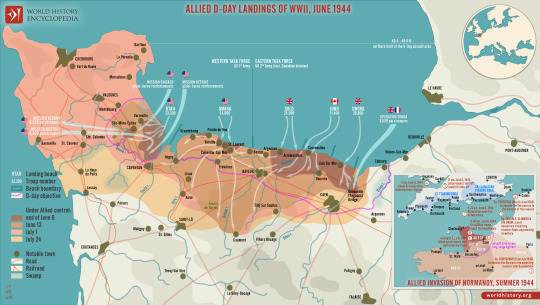
Where to Attack?
Operation Overlord, which sought to attack occupied Europe starting with an amphibious landing in northwest France, Belgium, or the Netherlands, had been in the planning since January 1943 when Allied leaders agreed to the build-up of British and US troops in Britain. The Allies were unsure where exactly to land, but the requirements were simple: as short a sea crossing as possible and within range of Allied fighter cover. A third requirement was to have a major port nearby, which could be captured and used to land further troops and equipment. The best fit seemed to be Normandy with its flat beaches and port of Cherbourg.
The Atlantic Wall
The leader of Nazi Germany, Adolf Hitler (1889-1945), called his western line of defences the Atlantic Wall. It had gaps but presented an impressive string of fortifications along the coast from Spain to the Netherlands. Construction of gun batteries, bunker networks, and observation posts began as early as 1942.
Many of the German divisions were not crack troops but inexperienced soldiers, who were spending more time building defences than in vital military training. There was a woeful lack of materials for Hitler's dream of the Atlantic Wall, really something of a Swiss cheese, with some strong areas, but many holes. The German army was not provided with sufficient mines, explosives, concrete, or labourers to better protect the coastline. At least one-third of gun positions still had no casement protection. Many installations were not bomb-proof. Another serious weakness was naval and air support. The navy had a mere 4 destroyers available and 39 E-boats while the Luftwaffe's (German Air Force's) contribution was equally paltry with only 319 planes operating in the skies when the invasion took place (rising to 1,000) in the second week.
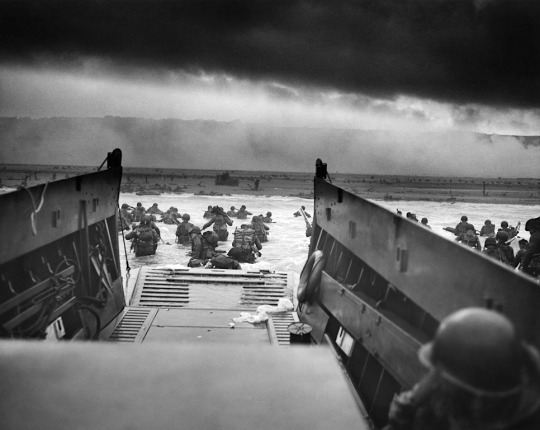
Neptune to Normandy
Preparation for Overlord occurred right through April and May of 1940 when the Royal Air Force (RAF) and United States Air Force (USAAF) relentlessly bombed communications and transportation systems in France as well as coastal defences, airfields, industrial targets, and military installations. In total, over 200,000 missions were conducted to weaken as much as possible the Nazi defences ready for the infantry troops about to be involved in the largest troop movement in history. The French Resistance also played their part in preparing the way by blowing up train lines and communication systems that would ensure the defenders could not effectively respond to the invasion.
The Allied fleet of 7,000 vessels of all kinds departed from English south-coast ports such as Falmouth, Plymouth, Poole, Portsmouth, Newhaven, and Harwich. In an operation code-named Neptune, the ships gathered off Portsmouth in a zone called 'Piccadilly Circus' after the busy London road junction, and then made their way to Normandy and the assault areas. At the same time, gliders and planes flew to the Cherbourg peninsula in the west and Ouistreham on the eastern edge of the planned landing. Paratroopers of the 82nd and 101st US Airborne Division attacked in the west to try and cut off Cherbourg. At the eastern extremity of the operation, paratroopers of the 6th British Airborne Division aimed to secure Pegasus Bridge over the Caen Canal. Other tasks of the paratrooper and glider units were to destroy bridges to impede the enemy, hold others necessary for the invasion to progress, destroy gun emplacements, secure the beach exits, and protect the invasion's flanks.
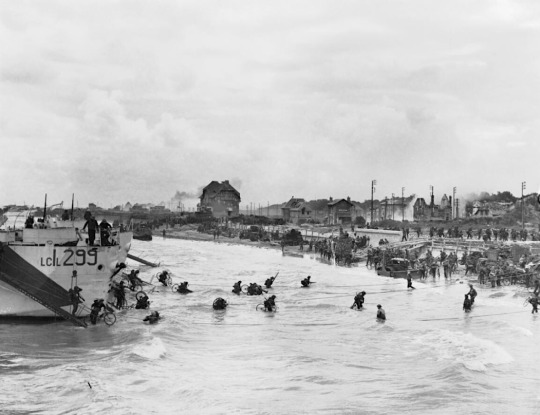
The Beaches
The amphibious attack was set for dawn on 5 June, daylight being a requirement for the necessary air and naval support. Bad weather led to a postponement of 24 hours. Shortly after midnight, the first waves of 23,000 British and American paratroopers landed in France. US paratroopers who dropped near Ste-Mère-Église ensured this was the first French town to be liberated. From 3.00 a.m., air and naval bombardment of the Normandy coast began, letting up just 15 minutes before the first infantry troops landed on the beaches at 6.30 a.m.
The beaches selected for the landings were divided into zones, each given a code name. US troops attacked two, the British army another two, and the Canadian force the fifth. These beaches and the troops assigned to them were (west to east):
Utah Beach - 4th US Infantry Division, 7th US Corps (1st US Army commanded by Lieutenant General Omar N. Bradley)
Omaha Beach - 1st US Infantry Division, 5th US Corps (1st US Army)
Gold Beach - 50th British Infantry Division, 30th British Corps (2nd British Army commanded by Lieutenant-General Miles C. Dempsey)
Juno Beach - 3rd Canadian Infantry Division (2nd British Army)
Sword Beach - 3rd British Infantry Division, 1st British Corps (2nd British Army)
In addition, the 2nd US Rangers were to attack the well-defended Pointe du Hoc between Utah and Omaha (although it turned out the guns had never been installed there), while Royal Marine Commando units attacked targets on Gold, Juno, and Sword.
The RAF and USAAF continued to protect the invasion fleet and ensure any enemy ground-based counterattack faced air attack. As the Allies could put in the air 12,000 aircraft at this stage, the Luftwaffe's aerial fightback was pitifully inadequate. On D-Day alone, the Allied air forces flew 15,000 sorties compared to the Luftwaffe's 100. Not one single Allied aircraft was lost to enemy fire on D-Day.
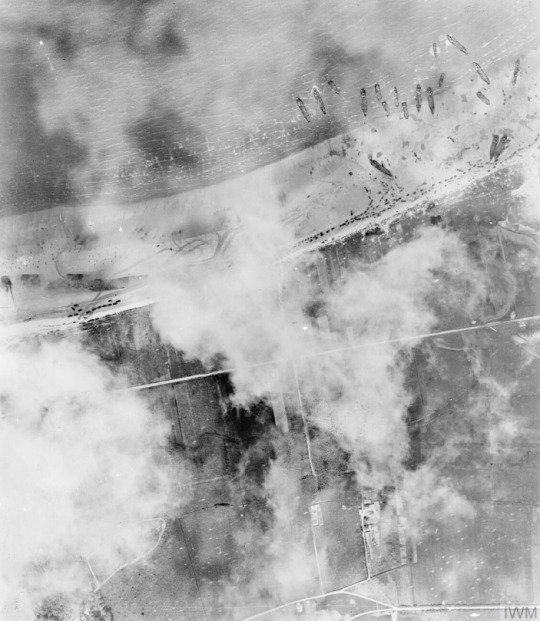
Packing Normandy
By the end of D-Day, 135,000 men had been landed and relatively few casualties were sustained – some 5,000 men. There were some serious cock-ups, notably the hopeless dispersal of the paratroopers (only 4% of the US 101st Air Division were dropped at the intended target zone), but, if anything, this caused even more confusion amongst the German commanders on the ground as it seemed the Allies were attacking everywhere. The defenders, overcoming the initial handicap that many area commanders were at a strategy conference in Rennes, did eventually organise themselves into a counterattack, deploying their reserves and pulling in troops from other parts of France. This is when French resistance and aerial bombing became crucial, seriously hampering the German army's effort to reinforce the coastal areas of Normandy. The German field commanders wanted to withdraw, regroup and attack in force, but, on 11 June, Hitler ordered there be no retreat.
All of the original invasion beaches were linked as the Allies pushed inland. To aid thousands more troops following up the initial attack, two artificial floating harbours were built. Code-named Mulberries, these were located off Omaha and Gold beaches and were built from 200 prefabricated units. A storm hit on 20 June, destroying the Mulberry Harbour off Omaha, but the one at Gold was still serviceable, allowing some 11,000 tons of material to be landed every 24 hours. The other problem for the Allies was how to supply thousands of vehicles with the fuel they needed. The short-term solution, code-named Tombola, was to have tanker ships pump fuel to storage tanks on shore, using buoyed pipelines. The longer-term solution was code-named Pluto (Pipeline Under the Ocean), a pipeline under the Channel to Cherbourg through which fuel could be pumped. Cherbourg was taken on 27 June and was used to ship in more troops and supplies, although the defenders had sunk ships to block the harbour and these took some six weeks to fully clear.
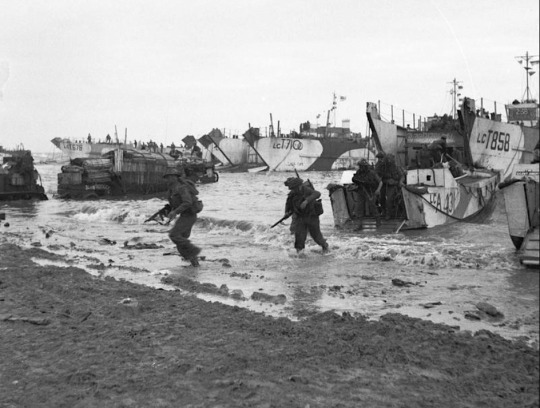
Operation Neptune officially ended on 30 June. Around 850,000 men, 148,800 vehicles, and 570,000 tons of stores and equipment had been landed since D-Day. The next phase of Overlord was to push the occupiers out of Normandy. The defenders were not only having logistical problems but also command issues as Hitler replaced Rundstedt with Field Marshal Günther von Kluge (1882-1944) and formally warned Rommel not to be defeatist.
Aftermath: The Normandy Campaign
By early July, the Allies, having not got further south than around 20 miles (32 km) from the coast, were behind schedule. Poor weather was limiting the role of aircraft in the advance. The German forces were using the countryside well to slow the Allied advance – countless small fields enclosed with trees and hedgerows which limited visibility and made tanks vulnerable to ambush. Caen was staunchly defended and required Allied bombers to obliterate the city on 7 July. The German troops withdrew but still held one-half of the city. The Allies lost around 500 tanks trying to take Caen, vital to any push further south. The advance to Avranches was equally tortuous, and 40,000 men were lost in two weeks of heavy fighting. By the end of July, the Allies had taken Caen, Avranches, and the vital bridge at Pontaubault. From 1 August, Patton and the US Third Army were punching south at the western side of the offensive, and the Brittany ports of St. Malo, Brest, and Lorient were taken.
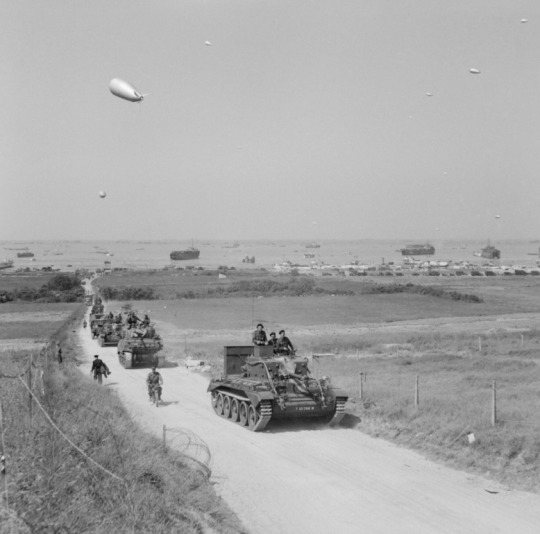
German forces counterattacked to try and retake Avranches, but Allied air power was decisive. Through August 1940, the Allies swept southwards to the Loire River from St. Nazaire to Orléans. On 15 August, a major landing took place on the southwest coast of France (French Riviera landings) and Marseille was captured on 28 August. In northern France, the Allies captured enough territory, ports, and airfields for a massive increase in material support. On 25 August, Paris was liberated. By mid-September, the Allied troops in the north and south of France had linked up and the campaign front expanded eastwards pushing on to the borders of Germany. There would be setbacks like Operation Market Garden of September and a brief fightback at the Battle of the Bulge in December 1944, but the direction of the war and ultimate Allied victory was now a question of not if but when.
138 notes
·
View notes
Text


A boat sails outside the port in Falmouth where the Bibby Stockholm is being refitted to house ~500 asylum seekers.
Sails read "YOUR SON YOUR BROTHER", "WE ARE BETTER THAN THIS"
145 notes
·
View notes
Text















V.01 ━━ M/Y Étoile. Commissioned in 2017 from an Italian Shipyard and delivered during the Summer 2019 in Monaco, the M/Y Étoile is a 6 levels yacht, and the replacement to the 'Nëperke' Yacht, his 2005 Sunseeker Predator 108. It was a much needed [ and desired ] upgrade to make justice to the position Le Chiffre now occupied within Quantum. It remained useful even past the takeover that Spectre went through by his hands in late 2019.
The boat's furniture was bespoke to his necessities, design to reflect little to nothing of his own personality and much of what he was perceived by others, and then crafted by an Italian atelier. As for the ship's internal structure, all finishes, such as the hardwood floors and ceilings, and details, such as the illumination coloring, were carefully chosen by Le Chiffre himself. The decor is nearly monochromatic, with the wood, soft lines and warm indirect lightening being a way to break the coldness of the palette and feign a sense of comfort to make it livable. The hull is painted in a mirror-like coating that uses a special coverage to avoid overheating the surfaces.

Another heavily customized feature of Étoile is the security infrastructure. The decks are all equipped with deck sensory arrays, which give an alert whenever people walk over it, as well as infrared beam sensors , lock-down vessel system, live CCTV and real time tracking by his team of choice. The ship is also equipped with an infirmary and an extremely well stocked armory. The Crew counts with a minimum of 4 security guards and an emergency surgeon in every trip it does.
The main deck is where all guest accommodations can be found, as well as the main lounging and guest entertainment areas. The vessel can comfortably fit 60 guests for events and 10 guests for travels in 5 rooms, divided between a VIP Stateroom, almost as well equipped as the Master Suite, two double cabins and two twin cabins. The upper deck holds the dining rooms and a private kitchen, as well as a sunbathing area and a bar. The fly deck, also known as owner's deck, is where the master suite can be found, equipped with a master bathroom and a walk-in closet, a small office space and a security control room can also be found at this deck. The sun deck holds only a small lounging area with a bar and another sunbathing area.
The lower deck is where the crew is accommodated, as well as most of the functional rooms, such as the laundry room, storage and pantries, can be found. The engine deck is where the technical rooms are found, such as the boat engine room, the infirmary and the armory.
Despite being considered his primary residence for many years, now the yacht spend most of the year docked either at Port Cala del Forte in Italy or the Falmouth Harbour Marina in Antigua, being only used by Le Chiffre when he want to travel in a more secure manner, or to entertain certain guests.
5 notes
·
View notes
Note
Dude dude dude. Wdym you know lots about Cornish history. Please share. I want this info dump. I want to know more. I will beg on my knees if necessary.
!!!!
I guess it depends on which period of Cornish history you wanna know about! I admit I don’t know a great deal about say Dunmonia or the really properly ancient culture in Cornwall. I take more of an interest in the social and industrial side of Cornish history. But I can give you a run-down of some parts of Cornish history you’ll never shut me up about!
The Cornish Jacobites and their rebellion in 1715! It actually had an impact on the 1745 rebellion, as well, as one of the Cornish Jacobite leaders’ (who was tossed in Newgate prison) family were suspected of harbouring Prince Charles Stuart, though it’s unlikely this did in fact occur. Actually this whole period is really interesting!
Cornwall during the French Rev wars!! So actually. In Cornwall, the ideas of Liberté, égalité, fraternité we’re quite popular. So popular in that in St. Just which was on the Tin Coast, a group of men planted a Liberty Tree. There was also a great deal of economic struggle (Cornwall has always been one of the poorest regions in the UK, however it was particularly drastic at this time, so much so that if you were a working family, you’d likely not be able to afford wheat for bread as it was extraordinarily highly priced). In fact, the officials of the area feared an uprising. I don’t have the number off the top of my head, but the reason they feared an uprising in Cornwall so much was because they’d be extremely outnumbered. Like I said, don’t have the precise number but it would’ve been a blood bath. Though luckily enough, the wars would very soon come to an end. Until the Napoleonic Wars kicked off.
Cornwall during the Napoleonic Wars is just. I could write a book or a very, very long essay. It’s also a very important time for industry. However Cornwall also held a unique position, being so close to France. French refugees trying to flee the war would be snuck across the channel and into Cornwall. They would also be given English names and set up with work. Not official, by the way. This wasn’t exactly a government approved activity. However there were also a few prisoner of war camps in Cornwall, a notable one in Roskrow. Detectorists must have a blast there… I’m also extremely emotional about one Captain James Quick, a St. Ives merchant captain who was taken a prisoner of war after setting sail from Falmouth and his ship, the Hopewell, becoming extremely damaged, losing all sails and being driven to the French coast and grounded in November 1810. He married his wife in just September. I actually have read the letters he wrote to his wife Harriett during this time and Christ. It’s a hell of a thing. He eventually made it home in 1814.
Industry in Cornwall is something I’ve touched on already a bit. But mining, fishing and farming were the biggest. And there’s the technology developed for it. One day I’ll need to talk in depth about the submarine mines, specifically Levant Mine (though it is a truly horrific story). Levant was actually 600 meters deep and before the “man engine” men and boys would have to climb around 80 sets of ladders up and down every single day, twice a day, in extremely hot mines that, at their longest stretched a mile beneath the sea floor. It wasn’t uncommon for men to just pass out from exhaustion on the ladders. A beam engine was introduced, which is still there. The only one in Cornwall.
By WWI, Cornwall has been pretty well established as a major entryway for trade into and out of the UK. Falmouth was THE port of call for ages. However, there was something called spy mania. Officials were worried German spies may use Cornwall to get into the country. This led to mass incarcerations of “spies” (many of whom were proven innocent) and subsequent executions. However even if you weren’t a spy, people coming into the country could be detained, thrown into a jail/workhouse and then drafted against their will into the war. It would have been a horrifying time to try and come into the country. On the topic of world wars and Cornwall, there are some places — one, I actually believe around Falmouth — where coastal defences managed to sink German uboats and at low tide you can even walk out to them (or at least they become exposed enough you can clearly make them out).
Once the tin and copper dried up, many Cornish miners were told they could have free land in places like Australia (and if this sounds a bit like what the US government told labourers in the mid 19thc, well it’s a theme). Besides Australia, many MANY miners also went to North America. In Mexico there’s even a town called Real de Monte, sometimes called “Little Cornwall” for its Cornish heritage there. Some Cornish miners also went as far West into America as California — again, which has a number of Cornish names about — and into the Appalachians and all along the east coast. The Hoosac Tunnel Disaster in 1853 was heavily being worked by Cornish immigrants and took over 20 years to complete.
I’ve not even touched on the language and the rebuilding thereof, nor cultural history or festivals. Or the smuggling!!! Or the civil war!!! Or it’s number of rebellions!! As I say, it really depends on which era and what aspect of Cornish history you’d be interested in learning about! I just kinda did a quick play by play, highlights! I highly recommend going to Kresen Kernow’s website (archives in Redruth) as well as the Royal Cornwall Museum which has quite a few digitised records in their online archives. Bodmin War Museum and the Falmouth Maritime Museum are also very useful! And if you ever go to Cornwall, PLEASE go to the local museum! You won’t believe the kind of things the volunteers will tell you or the absolute wild history of some of the objects. I can also recommend some reading, too.
#please don’t beg on your knees#I will happily always talk Cornish history#I’m just shy lol#anyways YEA!! there’s A LOT of history here and while I have my own specific areas of interest I did want to cast a wide net lol#pls feel free to ask me about anything here#gonna get sad thinking about James Quick brb#thanks for the ask!!!!!#<33333
7 notes
·
View notes
Photo


Sometimes I really want to read a short summary of what to expect from a game… and thankfully people can also submit their summaries of games they played and help me (and others) find games that cater to their interests!
submitted by @lairofsentinel
(click here for other videogames)
what to expect from Return of the Obra Dinn
Game from the same creator of “Papers, Please”. This alone speaks a lot in my opinion: we are expecting an unconventional and interesting game despite their visual.
This is an adventure, puzzle game which doesn’t have puzzles in the sense of contraptions or codes or following patterns. The “puzzle” is to reconstruct the story of what happened in the ship by using logic and deductions.
Despite looking like a difficult game, its core is basic deduction that we use every day, making assumptions, testing them, and remaking new ones if they were incorrect. For this I highly recommend it even for those who always are afraid of puzzle/detective games.
The story starts with an empty ship that drifts into the port of Falmouth with damaged sails and no visible crew.
You play as an insurance investigator who has been dispatched immediately to Falmouth, and has to make an assessment of the damages it suffered, this implies to understand what events happened on the ship, how many people were there, how they died, and their names.
The only tools you have is a book with some drawings of the crew, a list of the crew, a map of the ship, and a magical pocket-watch that allows you to see the last minutes of a corpse. This will provide us images, dialogues, and situations that will give us small bits of information to determine who is who and how they died.
I highly recommend this game even for those who are not much into mystery games, because the skills used in this game are not the typical intricate and sometimes artificial tricks you need to “see” to solve puzzles. Most of the clues are given by noticing accents, listening dialogues, making assumptions that come from these bits, and observations of situations frozen in time.
The story of the travel of this ship since it sailed until the last crew member was alive starts simple but unfolds beautifully, trapping you in the mystery that is slowly built up with dialogues and the progression of death scenes.
The journal that the game gives you is beautifully organised and really useful for your deductions. The game truly provides all what you need to work on this at your own pace.
The mechanics are simple, the story is epic and surprising [you are not going to get bored trying to figure it out what happened] and the mystery keeps building up all along the game until the last moment, where the last pages of the journal are available, and you can discover a last, final secret.
Wonderful music, excellent voice acting, and unique visual style that work all together, providing a pleasing environment to play and keep engaged.
The only two small cons that sometimes I found out is that because the lack of detail in the images due to its style, sometimes it’s a bit complicated to understand the cause of death of a character. But the game is quite forgiving on that matter [for example, you may assume different ways to describe a death that are similar and all of them are correct for the game]. The other con is that you lose some clues if you are not too good to spot accents in the dialogues. However, it’s not impossible since I’m completely unable to determine English accents and I didn’t feel it was a terrible barrier to play this game.
As a warning, it’s a game about deaths, so it’s a bit morbid, violent, and graphical at times, but I would not qualify it as “gore”. I suppose this is the reason why the game has picked this art style: it helps a lot to reduce the roughness of the death situations you will see. Even though it’s explicit, it’s not detailed.
——- Plot? ——-
In 1802, the merchant ship Obra Dinn set out from London for the Orient with over 200 tons of trade goods. Six months later it hadn't met its rendezvous point at the Cape of Good Hope and was declared lost at sea. In 1807, the Obra Dinn returns, drifting to the port Falmouth with damaged sails and no visible crew. As an insurance investigator, you need to board the abandoned ship and determine what happened with its crew.
——- Gameplay? ——-
You walks around the ship, exploring, seeking corpses/skeleonts over which you activate the pocket-watch, and see the memory of the last minutes of that person. Sometimes, inside these memories, you can find new corpses that the pocket-watch will allow you to explore. These second corpses will appear like holograms in the real ship later. This allows an easy access to revisit some deaths.
——- Characters? ——-
60 crew members that you need to name and discover.
——- LGBT? ——-
None.
——- Sadness level? ——-
There is some sadness since this is a story about deaths, but the mystery overrides any sentiment. You just want to know what happened.
——- Happy ending? Deaths? ——-
The game ends when you discover all what can be discovered, and a new secret is available. It’s not happy nor sad, since as I said before, it’s a story about death and how rough life can be on a ship. Some deaths are tragic events, others are product of human greed, but the game hooks you so much with the mystery, that there is no much space for sadness even though it’s truly a tragic story. The ending is satisfying because everything ends up fitting adequately.
43 notes
·
View notes
Text
Day Ninety-nine
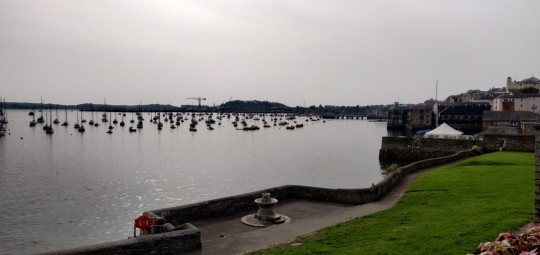
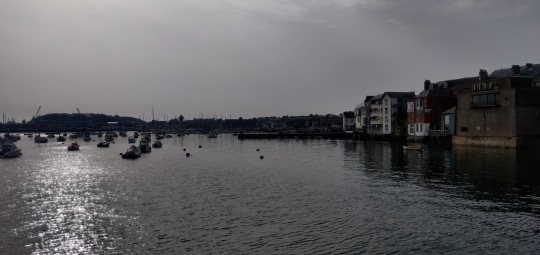

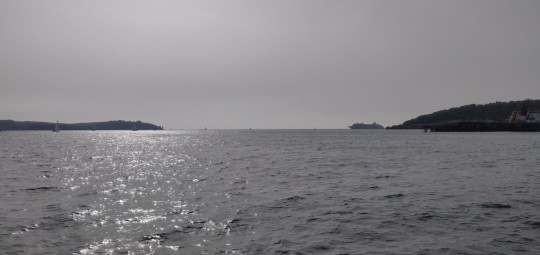





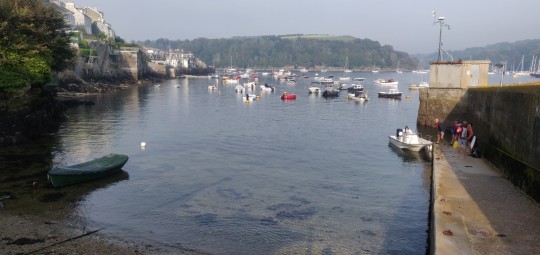
It's a very grey start to today, with a light cloud cover coating the skies.
Up out of the bridleway spot and back onto the road near Constantine, it's straight into the hills as the road leads up into Cornwall's high surroundings as I continue my heading east.
It's some rolling hills to tackle as I slog along the road through some busy morning traffic, until finally riding in to the edges of Falmouth.
The busy port town is full of climbs as I track around and make my way down to the harbourside, where I get a beautiful view across Carrick Roads whilst waiting for the ferry.
After a brief stint afloat and savouring the waves, I put in across the water at the beautiful town of St Mawes.
Heading up past the castle, with some lovely views back across the water, it's up the steep hills once more to start slogging along the road again.
The rising sun is doing its best to burn off the light cloud cover of the morning, and the heat is rising once more as I get to rejoin NCN Route 3 for its stint along the coastline here.
Dropping down past Carne Beach, the route begins a heavy section of steep climbs and drops as it tours around the beautiful coastal area, zig zagging round to take in the many bays and watersides as it makes its way around the cliffsides.
Around and past the steep drops through Portmellon and Mevagissey, the route finally heads off the roads for a long hard climb over the lovely gardens of Heligan, before crossing the road and heading on to St Austell River.
It's a wonderful stretch of off-traffic riding herr as Route 3 follows up the river's course, through some beautiful forested areas, until heading in to St Austell at the heaving A390.
With Route 3 continuing northwards, I head off the cycle route and in to town for a resupply stop and break, before carrying on around the very busy roads to head on towards Par.
Whilst riding along the trails here, the bike lurches to a very sudden stop. A glance down has my heart in my mouth as a rather large branch has managed to find its way into the spokes of my rear wheel, catching the struts of my mudguard, and wrenching everything round. The mudguard has folded near double on itself and is sticking out towards my knee, and the branch is firmly wedged in amongst the wheel.
I stop to assess the damage as this could be pretty disastrous. After managing to extricate the offending piece of wood, I get the mudguard to unfold and slot back into its place without much harm done, and a check of the wheel finds that it's not even much out of true.
What on earth is with this bike?! An absolute tank! I can barely believe that no serious damage has been caused from this incident, but everything seems to be rolling ok, so I guess that means on with the show!
Round to Par and through it's looping one-way system, it's up another big sharp hill to head over to Fowey, with a steep descent through some narrow paths leading to some steps down to my second ferry of the day.
After a short wait and chat with some other tourists waiting, it's aboard the small ferry for a short cruise over the River Fowey to land at the working harbour at Polruan.
With the day wearing on, the heat and work haven't ceased yet, as from the waterside the road leads up and up a long and steep hill to get through and out of the pretty seaside village.
Finally up onto the coastal moorlands, I think it's been another long and tough day's work, so it's time for me to get scouting for a spot to lay my head. Tomorrow should hopefully have me pushing on and out of Cornwall's challenging hills.
TTFN!
10 notes
·
View notes
Text
Joseph Antonio Emidy and The Music We Lost
"This remarkable man was the most finished musician I ever heard of, though I have had the privilege of listening to most of the stars who have appeared on the London stage during the past fifty years, but not one of them in my estimation has equalled this unknown negro." -William R. Tuck on Joseph Emidy

Read on after the cut:
Born somewhere around the year 1775 in Guinea and sold to Portuguese slavers as a child, Joseph was first taken to Brazil and then to Lisbon, Portugal. His owner recognized his musical talents and sought to cultivate them by providing Joseph with violin lessons from a professional musician. In a short three or four years, he was proficient enough to be playing in the second violin section of the pit orchestra for the Lisbon Opera. As someone who plays violin, I have to point out that violin has one of the toughest technical learning curves for a beginner, and to be playing professionally after only four years of serious lessons is impressive AF. He was still enslaved at this time, a fundamentally unjust situation to be in, but it seems at the least that he was allowed to flourish musically.
Enter Sir Edward Pellew, captain of the HMS Indefatigable. At the outset of the French Revolutionary Wars, the Indefatigable met up with the Tagus in the port of Lisbon and the officers went ashore to attend the opera before sailing into the Mediterranean. While there, Emidy seems to have caught Pellew's eye, perhaps because he may have been the only black violinist in the second violin section.
Pellew was aware that fighting the French was going to be a years-long campaign, and that his men would be badly in need of something to help bolster their morale along the way. Thus, by the end of the concert he had directed his men to press-gang Emidy as he left the theater to ensure that they would have a good fiddler to entertain them on ship during the war.
So when you hear about crews kidnapping musicians just so they could have entertainment on board this is the chief canonical example of just that. And as much as Admiral Pellew is admired for his bravery and cunning throughout his career, I can't help but see the flip side of that same mindset, the part that was okay with casually kidnapping someone from an orchestra on the coldly calculated basis that he would be the least likely to be missed.
For approximately four years Emidy served in the Royal Navy as the crew's chief source of onboard entertainment, playing the fiddle for them so they could dance in the evenings. He was not allowed shore leave from the HMS Indefatigable during the entirety of that time, because he was openly miserable about his situation and they feared he would abscond at the first opportunity. Who can blame him? At last, in 1799 Pellew received a commission for the Impetueux. Seeing that he couldn't keep his fiddler much longer, he discharged Emidy at the docks of his home base in Falmouth, Cornwall.
Emidy became an integral part of Cornwall's music circuit, performing regularly at concerts, theatres, and assemblies in various parts of the county, in addition to giving music lessons. He wrote numerous compositions which were held in high enough regard locally that a young James Silk Buckingham (who had taken music lessons with Emidy) was moved to travel to London in 1807 to present some of them to composer and impresario Johann Peter Salomon and his circle of music professionals. While Salomon was intrigued enough to offer Emidy a chance to come perform in London, others warned that even with his talent he would face an uphill battle against the racial prejudices of Londoners. In Cornwall, they argued, at least he was already well-known and well-liked. Ultimately, he remained in Cornwall.
This London meeting happened at about the same time that violin virtuoso George Bridgetower was elected to the Royal Society of Musicians and began working towards his bachelor's in music at Trinity Hall, Cambridge. Perhaps Bridgetower was given more of a pass by London society because he was mulatto, and because of his (somewhat alleged) noble lineage. Emidy was wholly of African descent and a former slave. His abilities had the potential to pose uncomfortable questions to an English society newly grappling with the issue of abolition (the first Abolition Act, which banned the direct purchase of enslaved people from Africa, was passed right in 1807). If nothing else, this experience made an impression on Buckingham, who went on to become an ardent abolitionist and social reformer. On Emidy, Buckingham wrote, "With the same advantages as were enjoyed by most of the great composers of Europe, this man might have become a Mendelssohn or Beethoven; but as it was, it was the achievement of extraordinary perfection, in spite of a thousand obstacles or difficulties."
Emidy lived the rest of his life in Cornwall, making his round of gigs, teaching, and composing. He married Jenefer Hutchins in 1802 and the couple went on to have at least six children (some sources say eight). He died in 1835 at the approximate age of 60, and is buried in Kenwyn Parish Church in Truro.
Several different sources attest to a variety of compositions that Emidy wrote over the course of his career, including chamber music, symphonies, a horn concerto, and several pieces for violin. None of these pieces have been found, at least not yet. It's not so unusual for the time to have no trace of a composer's works, as there was no concerted effort to preserve music that was going out of fashion (and musical tastes changed quite rapidly during this period). But it is extremely disappointing that someone didn't hold onto this music, especially since it seems to have garnered some high praise.
9 notes
·
View notes
Text
We have been very lucky in Falmouth since the 17th June - The Falmouth Art Gallery on the Moor has hosted an amazing exhibition:
The Legend of King Arthur: A Pre-Raphaelite Love Story
I have been a fan of Pre-Raphaelite art for years, even going so far as to organise a tour of art galleries across the UK in 2011 to see famous pieces by Millais, Holman-Hunt, Maddox-Brown and Rossetti among others. I was elated when I discovered that this exhibition was occurring so close to home, especially since it ties in my love for Arthurian myth and legend also.
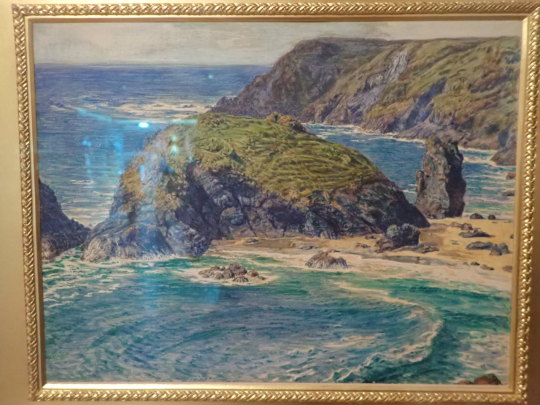

Possibly my favourite Pre-Raphaelite piece is the Scapegoat by Holman-Hunt, which hangs in the Lady Lever Art gallery in Port Sunlight, Liverpool. I smiled in my soul when I saw the above piece by the entrance, a surprisingly small landscape by Holman-Hunt. I was very surprised to discover that he had visited Cornwall at all, let alone painted somewhere I had visited and been familiar with. I enjoy Holman-Hunt's highly detailed, yet somehow simple pieces, with careful attention paid to the minutiae of the rock formations and portrayal of the damp and dry sand on the shore. A lovely piece.
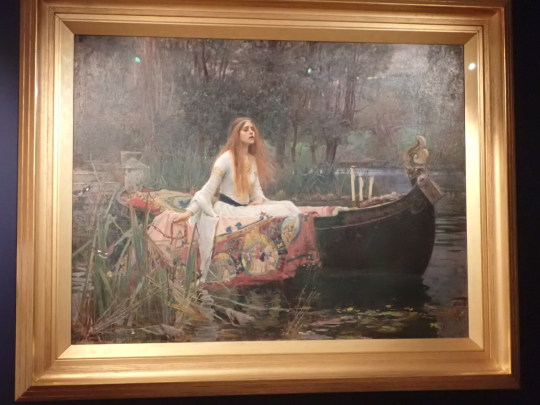
The main draw of the whole exhibition was "The Lady of Shallot" by Waterhouse. I had not seen this piece in the flesh as it were before, but was taken aback by its actual size, I had surmised it was smaller. It certainly draws the attention like no other painting in the room. I sat and sketched this in the gallery and drew the attention of some of the other patrons, one man, a pastel artist in his spare time, called me brave for being able to sit and sketch. This struck me as something I had not thought of before about my character. Does it require bravery to be a creative? To want to capture something you see without regard of the thoughts of others who might watch you do so? I pondered this while I drew, but was inspired to work on something similar to the Lady of Shallot in the future maybe. It really is a remarkable piece.
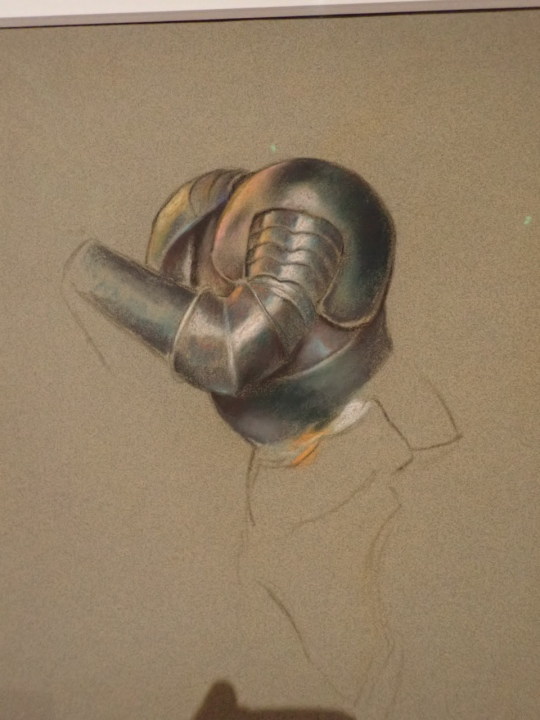

Speaking of pastels, I was blown away when I closely inspected this piece by Evelyn De Morgan. On first glance, this is a sketch in pastel of a suit of armour, plaing silver/grey in appearance. If you pay close attention to the work, neither grey nor silver are used in the composition! I will leave it to mystery as to what actually makes it up, but rather than ponder the meanings of the work this sketch informed, I was totally taken away by her material use and technique. Something which, as time passes, is deeply informing my thinking.
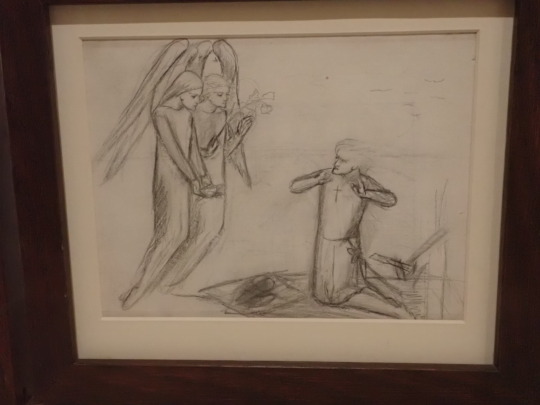


Last but most certainly not least, I adored being able to see some work by Elizabeth Siddal. Her story is very familiar to me as part of the wider Pre-Raphaelite canon story, but in all my travels to see Pre-Raphaelite work, I had not come across her work in this manner before. Being largely untutored in art before meeting her future husband, Dante Gabriel Rossetti, she displayed some talent, enough to pique the interest of John Ruskin, renowned enough that I need not explain who he is. I immediately fell in love with the simplicity of these pieces. It made me wonder; does drawing have to be significantly complex or break new ground to be considered worthy of entering the canon of art? Do we have to have a tragic story in order for our work to be considered posthumously? On the whole - why can't we all be remembered for our creations? No matter how simple they may be?
In short, if you are in Falmouth, please stop by this wonderful exhibition and spend as much time as you can soaking in these wonderful pieces and more! You have until 30th September!
#drawing#exhibition#falmouth#pre raphaelite#king arthur#dante gabriel rossetti#william holman hunt#edward burne jones#evelyn de morgan#elizabeth siddal#john william waterhouse#the lady of shalott#kynance cove
3 notes
·
View notes
Text
February 18, 1809
Rose 1/2 p. 9. Pas tro. bi. Hate m’habiller. Conge peruke¹. Sor. 1/4 before p. 11. To 6 Arlington street. Lord M. not up. Desired to call at 12. Walked home in the rain. At 12 took coach, 2 shillings 6 pence; found him; received in the most kind and frank manner. After sitting 1/2 hour, he was called down, a gentleman desiring to say one word to him. It was to inquire if C.B.² were not there, which being answered in the affirmative, he apologized and went of!! Not known to Lord M. Sat an hour. Of his advising the ministry of being taken into the administration; of the war in Spain. To cabinet-maker’s, Green street. To Mr. Duval’s; out. To Mr. Achaud’s. M’lle A. began to ask of M’lle Duval. Tres hont rec. par³ Madame A. and M’lle. Stopped to take jelly and cake. Faib. et fat.⁴ Voila Madame P.⁵ To 14 Harper street, Mr. Humphreys; he has seen T. and arranged a suspension of hostilities for eight days. Fatig⁶. Took coach to Horse Guards; General Hope out; got the daily table of packets, &c. The packet Express, with my interesting letters of October and December, still in port at Falmouth. What fatality! Home at 5. Coach-hire, 3 shillings. Mem.: Renc. Madame Harris; pri. ad.⁷ Dinner, ham and potatoes. At 7 sor. to Gilbert’s, shoe-maker. Renc. pet.; 3 shillings 6 pence. Mal.⁸ To Q.S.P. at 8. Recontra J.B. Son avis⁹, &c. Home 1/2 p. 9. Mal tête¹⁰. Cre. tar. punch, which kept me up till 5. Madame P. sat with me till 3 and nursed me with great tenderness.
1 Not very well. Hasten to dress myself. (Je me hâte de rn’habiller.) Take leave of my wig. 2 Meaning himself—Colonel Burr. 3 For tres honnetement reçu par. Very genteelly received by. 4 For faible et fatigué. Weak and tired. 5 There is Madame P. 6 For fatigué. Tired. 7 For Rencontrai Madame Harris; [je la] priai [de me donner son] adresse. Met Madame Harris and asked her for her address. 8 For Rencontrai [une] petite [demoiselle or femme.] 3 shillings 6 pence. Mal. Fell in with a little woman. 3 shillings 6 pence. Bad! 9 Met J.B. His opinion, &c. (rencontrai.) 10 For mal à la tête. Headache.
6 notes
·
View notes
Text
Specific locations + times can be found on the Answer Coalition's website

Locations by state/country in alphabetical order pasted directly from the above (please go to the link for specific times & check for frequent updates!):
Albuquerque, New Mexico
Alfred, NY
Angelica, NY
Arequipa, Peru
Asheville, North Carolina
Atlanta, Georgia
Austin, Texas
Baltimore, Maryland
Belmont, NY
Boston, Massachusetts
Brainerd, Minnesota
Boise, Idaho
Burlington, Vermont
Calgary, Alberta
Caracas, Venezuela
Charlotte, North Carolina
Charlottesville, Virginia
Champaign-Urbana, Illinois
Cincinnati, Ohio
Coatesville, Pennsylvania
Columbus, Ohio
Corner Brook, Newfoundland and Labrador
Cornwall, Ontario (Canada)
Davis, California
Dayton, Ohio
Denver, Colorado
Detroit, Michigan
Eastham, Massachusetts
Flagstaff, Arizona
Falmouth, Massachusetts
Havana, Cuba
Fayetteville, Arkansas
Fort Wayne, Indiana
Fresno, California
Gainesville, Florida
Geneseo, New York
Grand Rapids, Michigan
Hamilton, Ontario
Houghton, NY
Huntsville, Alabama
Indianapolis, Indiana
Jamaica Plain, Massachusetts
Joshua Tree, California
Kansas City, Missouri
Kingman, Arizona
Kuala Lumpur, Malaysia
Lander, Wyoming
Las Cruces, New Mexico
Las Vegas, Nevada
Los Angeles, California
Manchester, New Hampshire
Martinsburg, West Virginia
Memphis, Tennessee
Milwaukee, Wisconsin
Mineral Point, Wisconsin
Nanaimo, British Columbia (Canada)
Nashville, Tennessee
New Orleans, Louisiana
New Paltz, New York
New York City, New York
Oklahoma City, Oklahoma
Olean, NY
Peterborough, Ontario
Pensacola, Florida
Phoenix, Arizona
Philadelphia, Pennsylvania
Pittsburgh, Pennsylvania
Pompano Beach, Florida
Portsmouth, New Hampshire
Port Angeles, Washington
Portland, Maine
Portland, Oregon
Providence, Rhode Island
Raleigh, North Carolina
Richland, Washington
Rochester, New York
Salt Lake City, Utah
San Antonio, Texas
San Diego, California
San Juan, Puerto Rico
Santa Barbara, California
San Francisco, California
Savannah, Georgia
Seattle, Washington
Seoul, South Korea
Spokane, Washington
Springfield, Massachusetts
Springfield, Missouri
St. Louis, Missouri
Syracuse, New York
Tallahassee, Florida
Taos, New Mexico
Tillamook, Oregon
Tri-Cities, Washington
Tokyo, Japan
Toledo, Ohio
Troy, New York
Tucson, Arizona
Tulsa, Oklahoma
Ventura, California
Victorville, California
Wailuku/Kahului, Hawai'i
Washington, D.C.
Waukegan, Illinois
Wellfleet, Massachusetts
Note: This is an incomplete list. Please check with local organizers if you don't see something near you! Just because something isn't listed here doesn't mean it's not happening!
there are going to be global demonstrations for Palestine on march 2nd, this site has more info
here's what's written on the front page:
"On March 2, millions across the world will march for Gaza! The Israeli government is planning to have a full-scale invasion of Rafah one week later, on March 9, one day before the start of Ramadan. Today, the United States vetoed a UN resolution that insisted that Israel immediately cease its mass killing spree in Gaza.
Now is the time to act! People around the world are going into the streets in cities and towns, including in the United States, as part of the global day of protest on Saturday, March 2.
Gaza is facing famine, its hospitals are besieged, threats of ground invasion in Rafah loom near, and Israel continues its onslaught on the over 2 million Palestinians in the Gaza Strip.
The mass movement for Palestine has led to the isolation of the US and Israel on the world stage. With growing internal divisions and heightened political pressure on Israel and the United States, it’s time to push even harder. Our mobilizations at this moment can be more decisive than ever, and we must show our full strength now to ensure a lasting ceasefire and an end to the siege on Gaza.
Act now, and mobilize in your communities and institutions, everyone must be on the streets on March 2nd! All out for Rafah! All out for Gaza! Stop the genocide!"
11K notes
·
View notes
Link
If you are ending or starting your cruise in Jamaica, then book your transportation from the port to your accommodation or from your accommodation to the port in Falmouth. #Tours2Go #ToursToGo
0 notes
Text
Explore Tours in Jamaica by Fowler's Taxi & Tours
Jamaica offers a wide range of tours to suit every type of traveler, from beach lovers and history buffs to thrill-seekers and nature enthusiasts. Here are some popular tour options:
Dunn's River Falls Tour
Location: Ocho Rios
Experience: Climb the famous terraced waterfall, swim in natural pools, and enjoy lush surroundings. Often includes zip-lining or ATV excursions nearby.
Bob Marley Museum Tour
Location: Kingston
Experience: Visit Bob Marley’s former home, now a museum dedicated to his life and legacy, with personal artifacts, music history, and guided tours.
Blue Mountain Coffee Tour
Location: Blue Mountains
Experience: Hike or bike through the scenic Blue Mountains, tour coffee plantations, and enjoy fresh, world-famous Blue Mountain coffee.
Luminous Lagoon Night Tour
Location: Falmouth
Experience: A night boat tour to see bioluminescent microorganisms that make the water glow, creating an enchanting light show.
Appleton Estate Rum Tour
Location: St. Elizabeth
Experience: Tour one of Jamaica’s oldest rum distilleries to learn about rum-making and enjoy tastings of premium Appleton Estate rum.
Martha Brae River Rafting
Location: Near Montego Bay
Experience: A peaceful bamboo raft ride down the Martha Brae River, guided by locals who share stories and knowledge of the area.
Pelican Bar Tour
Location: Parottee Bay, off the coast of Treasure Beach
Experience: Take a boat ride to this rustic bar in the middle of the ocean, enjoy local drinks, and relax with spectacular ocean views.
Nine Mile Tour
Location: Nine Mile, St. Ann
Experience: A tour of Bob Marley's birthplace and resting place, complete with reggae music and Jamaican history insights.
YS Falls
Location: St. Elizabeth
Experience: Swim in natural pools, enjoy waterfall cascades, and try zip-lining above the lush landscape.
Negril’s Seven Mile Beach & Rick’s Cafe
Location: Negril
Experience: Spend a day on the famous Seven Mile Beach, followed by cliff diving and sunset views at Rick’s Café.
Port Royal Historical Tour
Location: Kingston
Experience: Explore this historic port town, known for its pirate history, and visit the Giddy House and Fort Charles.
FowlersTaxiTours #ExploreJamaica #JamaicaTours #JamaicaTaxiService #IslandAdventure #DiscoverJamaica #JamaicanVacation #TourJamaicaWithFowler #FowlersToursJamaica #JamaicaTravel #JamaicanExperience #VisitJamaica#ExploreWithFowler #JamaicaToursAndTransfers #AuthenticJamaica #LocalGuidesJamaica #TaxiAndToursJamaica #JamaicanAdventures #YourJamaicaGuide #IslandToursJamaica
Visit our website https://www.fowlerstaxiandtours.com
Call us at +1 876-346-3469
Email at [email protected]
0 notes